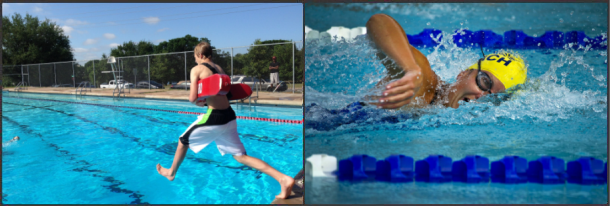Swimmers will use swimming goggles that are tinted mostly outdoors where it is very bright or in an indoor swimming pool, depending on the brightness of the lights. They work the same way sunglasses work by helping protect your eyes from bright light, especially if you are a competitive swimmer and swim using the backstroke.
How do I choose which swimming goggles are best for me?
If you frequently swim outside, you have no choice but to use swimming goggles. Inside, you will have swimming lanes with black lines on the floor to follow, ropes and walls. But outside, you are confronted with murky water and no help for your orientation. This is where having suitable swimming goggles is essential.
There are several criteria:
1. Finding the correct size and fitnesses
First and foremost, your goggles have to fit you perfectly. Water may leak inside if they do not fit correctly, compromising your swimming visibility. It will also be very annoying to keep having to stop mid-swim to adjust them. Goggles are often sold as a one-size-fits-all model so that it will come down to the size of the gaskets. There are two types of goggles styles. There are ones for open water, which will be bigger, and then there are other goggles which are more common; these will be smaller and sleeker, designed for racing in the water.

The piece in between the gaskets also varies in size and significantly impacts your swimming. When buying swimming goggles, you will be provided with sizes small, medium and large, from which you can choose. Preferable are customized swimming goggles.
2. Are the goggles for racing or recreational swimming?
If you swim recreationally, then you have more freedom in your choice of swimming goggles. Depending on whether you swim mostly inside or outside, you either get tinted goggles or an all-seasons option, the blue-tinted mirror goggles.
However, if you are racing, you will always have to have a couple of swimming goggles to have the right ones for the right occasion, conditions and weather.
3. Do I need UV protection?
UV protection is very common nowadays with any swimming goggles. You will be fine with swimming goggles without UV protection if you mostly swim indoors, but when swimming outside, you will have to have UV protection for health and safety reasons for your eyes.

4. What is the difference in colour lenses?
Colours in swimming lenses serve the purpose of enhancing visibility in specific conditions. Blue tinted lenses will reduce glare and will enhance colour vibrancy. Gold, yellow or orange tinted lenses increase clarity in low light as well as contrast and depth perception; these will be best for outdoor swimming. Black or grey lenses act as sunglasses, as they protect your eyes from bright lights or the sun. When choosing the right coloured lenses for yourself, consider the conditions you most often swim in.

5. Mirrored or non-mirrored lenses?
The mirror surface on lenses will reflect any light away from your eyes, reducing any possible glare and brightness. Mirrored lenses can be used inside and outside, but they are particularly effective for outdoor swimming due to the external lighting conditions.
In conclusion, there is a wide variety of swimming goggles you can choose from, but the best option would be to choose ones with mirrored lenses, UV protection and the appropriate colour lens. Swimming goggles are anyways mostly offered with UV protection and mirrored lenses, so it leaves you with only having to pick your desired coloured lense and check that they fit you perfectly.
Lifeguard Services




Leave a Reply